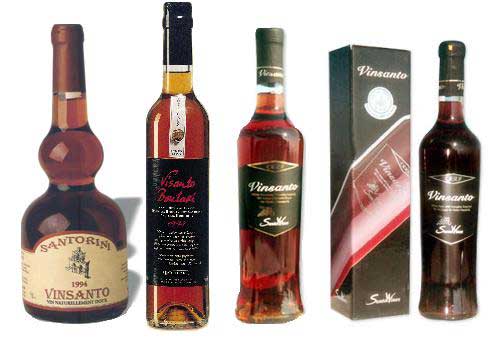Wine
There is evidence to support the claim that viticulture and wine making on the isle of Santorini is about 3500 years old. In the process of excavations at Aktoriti location, archaeologists discovered the blackened remains of kindling from burnt wine stalks. They also discovered grape pits in vases, as well as jars with floral paintings representing bunches of grapes, and a plethora of vessels, e.g. stirrup jars used for storing liquids, particularly wine. These findings lend credit to the claim that there existed wine trade activity in Santorini during the prehistoric period (c.a. 1700 BC).

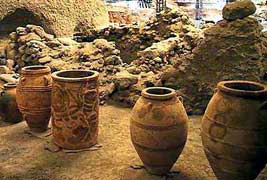
Viticulture in Santorini is the oldest in Greece. Hense, one could surmise that vines on the island are probably autochthonous, which can be supported by the fact that the Santorini vineyards have never been stuck by the phyloxera past.
Actually, the Santorini vines are among the few Europeans of the self-grown species.
Very likely that the resistance of the local vines to pests and diseases is the result of constitution in volcanic soil. The old autochthonous hours take a brief tour of the island's interior. You will not fail to notice that the vineyards are linked with "baskets" i.e. coils, of vine trellises rooted to the volcanic soil and rising at a height that, from some distance look like wicker baskets lying abandoned on the ground.

However, at the bottom of those "baskets" shoot roots deep into the soil. The vine trellises are very much alive, waiting for the sign of Spring to shoot eyes, and the hot breath of summer to bring forth precious bunches of grapes. This "basket weaving" was sterted by the local farmers hundrends of years ago, in an effort to protect the grapes from the strong north winds (meltemia) of August. Now, is seems that the vines are trained to run a circular path round the stalk and the result is a natural basket where grapes grow safely.
Irregular masonry structures, basically heaps of stones, are erected to provide additional protection to vineyards against wind erosion. Terraces from volcanic earth are built for the same effect, but also host patches of vineyards. The vineyards of Santorini haveevolved to require little water, as much as they can capture from the water vapours of the fog that covers the island in August. The water is trapped in the soil and the leaves of the plant. This unique microclimate of the island has a considerable effect on the grape varieties grown and on the quality of the wine produced.
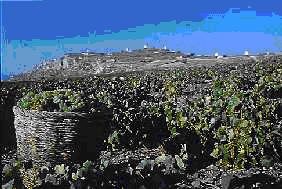
Wine grape varieties
In the beginning of the previous century approximately fifty wine grape varieties were cultivated on the island of Santorini. Currently, there are only thirty. The most popular white varieties are : Asirtico, Athiri, and Aidani. The equally important red varieties are: Mantilari, Mavrotragano, and Voudomato. The Athiri and Aidani grapes are cultivated in small quantities, but give excellent aromatic and full-bodied wines.
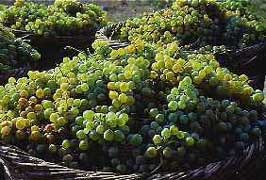
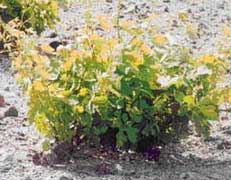
Other white grape varieties are: Aetonichi, Critico, Potamisi, Rozaki, Savatiano and Aspromoschato. Other red grape varieties are: Rousso, Moschato, Roditis, Fraoula, and Aetonichi. The black grape varieties are: Nychato, Eftakio tis klimatarias, Sariki and Mavrothyro.
Asistiko: This is the prevailing cultivar of Thera. It found purchase in the volcanic environment of the island to evolve into one of the most impressive varieties of Mediterranean vineyuards. This variety gives approximately 80% of total grapes produced on the island. The asirtiko variety produces one of the best white wines in Greece, distinguished for its high acidity and full-bodied aroma.
Athiri: This is an old variety grown on Crete and known for its thin skinned and aromatic grapes.
Aidani: This is a rare variety producing highly aromatic grapes in antiquity to produce the "Apiranthos" wine of Naxos. The aidani grapes are blended to add aroma to the Vinsanto wine.
The most famous wines produced in Santorini are the Nykteri (white wine, the Asirtiko and the Vinsanto. The former, Nychteri, took its name from the fact that farmers would harvest the particular vines until late at night (Gk. Nychta), when the temperatures dropped and toiling in the fields became bearable.
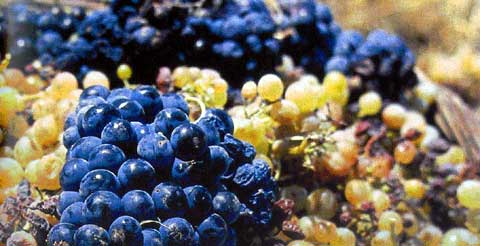
Sun-drenched grapes from the deep of the centuries
"But when Orion and Syrius are come into mid-heaven and rosy-fingered Dawn sees Acturus, then cut off all the grape-clusters, Perses, and bring them home. Show them to the sun for ten days ad ten nights: then cover them over for five and on the sixth day draw off into vessels the gifts of joyful Dionysus". Hesiod Works and Days, c. 700 BC.
This is a recipe by Hesiod for the production of sun-drenched wine. In antiquity the sweet wines were known as "????? pas??" (vinum passum). Wine varieties different in terms of modes of vinification which was a factor of geographical location. All wine production shared a basic process: following collection, the grapes were spread under the sun to lose half of their weight by dehydration. Subsequently, they were transferred to wine presses for the collection of must in pithoi (large clay jars), for fermentation. Occasionally, mature wines were added to the must in the pithoi to thus add aroma and character to the new wines. This process of vinification produced wines that were aromatic abd high in alcohol, which necessitated their dilution with cool, fresh water. In keeping with the name change of Santorini, this sweet wine, too, changed its name from 'Thera' (Lacedeminian) to 'Santo-Erini' (Italian).
As mentioned earlier this sweet wine was also referred to as Vino Santo or Voinsanto (i.e. sweet wine of Santorini) in the Middle Ages. The name Vinsanto was more sonorant, and also identified the origin of the wine to buyers around the world. Initially it was exported to Constantinople, Chandax (modern Heraklion), Chios and Smyrni. At a later time when Venice became a major marine power in the Mediterranean, this honey-like colour and aromatic wine conquered the markets of Venice Trieste, and Ancona and other destinations that the ships of the Most Serene Republic called at.
Thus, the Vinsanto was it great demand for the banquets of the nobles in the Middle Ages. At the same time it became indispensable among travelers, not only by dint of its rich taste, but also for the fact that it could act as a rich source of calories, invigorating the body to with-stand diseases and hardships that long and precarious navigation entailed. Enologist Mrs Kourakou-Dragonas found a reference to this Greek wine in contracts executed between the Venetian Republic and criews of sailors. The stipulation read that the wine was to be "administered" to the crew before breakfast. The Vinsanto was quite hardy, in the sense that it could endure long trips without going bad, which was considered an additional advantage for exports.
The Vinsanto respresnted the most lucrative business for the isle of Santorini. The particular viticulture became dominant, displacing all other cultures, on the island. The Koitsouk-Kainartzi Treaty (1774) paved the way for the Vinsanto to conquer the Black Sea region. By the end of the 18th c., and uo tp the first quarter of the 19thc., the bulk of the Vinsanto production was exported to Russia, whire it was also used for Communion in the Orthodox Churches.
However, the golden age of exports started to take a plunge in 1840 and never recovered until the beginning of the 20th century. This decline in Vinsanto exports was attributed to a radical restructuring of the international wine market during the 19th century. More specifically, the taste of consumers changed dramatically following technological developmentsthat facilitated the marketing and exports of competitive wines at great speed, relative to the previous centuries. The high price of the Vinsanto was also implicated for the demise of its exports. Prices were high on account of the geographical and terrain constrains associated with the particular viticulture on the rocky and rather inaccessible island. However, adjustments were made in the cost of production and in meeting the particular demands of the markets, in addition to upgrating the quality of Vinsanto. No sooner than demand for quality and brandname wines sterted to increase in the domestic market, did Vinsanto produ cers of Santorini start to reorganize productin, bottling and marketing. Following ten years of efforts, the Union of Theraic Products Association acquired full rights over the Vinsanto brand produced from the sundrenched grapes of Santorini and Therasia. Now, the wine is under the Protected Designation of Origin, thus fully protected against E.U. and third country competitors (EU regulation 753/2002, list B, 29 April 2002). This regulation has been in force since its publication in the Official Journal of the European Communities (4-5-2002).
Using a different process of production, the Italians produce a kind of sweet wine (vino santo) from other wine grape varieties. The European Union allows on the labels of designation of origin (DOC) Italian wines on condition that the term is supplemented by the geographical name, e.g. Vino santo di Damberella. Thus, the vino santo term, initially indicative of the Santorini wine made from sun-drenched grapes, lapsed to a general (generic) designation of sweet wines.

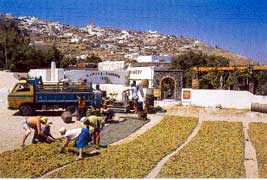
VINSANTO: A wine for connoisseurs
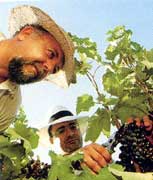
Just pour yourselves a glass of Vinsanto wine and simply look at it. Try to appreciate the hues as they change from golden yellow to orange to the Aegean turquoise and blue. Now, taste it carefully – as would a connoisseur: notice the complex aromas, the rich taste and exceptional balance. This is truly an aromatic wine which is counterbalance by the acidity of the Assyrtico grape component. There is no doubt that the Vinsanto's aroma is unique as it brings forth tastes of juicy citrus fruits, the sweetness of ripe figs and raisins, of plums and hints of cinnamon and vanilla. You may attempt to explain its sweetness, rich aromas and long aftertaste. Well, given that all good things in life require time, dedication and love, so does this "sacred" wine. The constituent wine grape varieties have long been embraced on this mysterious and legendary land, flourished on Santorini's volcanic earth and loved by the local growers and wine makers.
Following the toilsome vine harvesting the scorching heat of long summers, the particular grapes are strewn on steaming residential roofs under the Aegean skies. It does not take more than 15-20 days for the grapes to dry completely.
Subsequently the shriveled fruit is surrendered to the expert hands of wine makers to be processed with the sweet juice fermented in oak barrels. Fermentation lasts for several months, until Christmas, when it stops by itself, without the addition of alcohol (this explains the label: Vin Naturallment Doux). This wine needs at least 24 months maturation in oak barrels to acquire its exceptional bouquet. The wine comes out in high sugar content (at least 90gr/lt), velvety taste and proof between 8-10.9% depending on sugar percentage in the must. The yield is rather small: approximately 10kg of sundried grapes yields 2.5lt of Vinsanto. Having concluded this brief tour in the production process, let us return to more practical matters – taste and pleasure … The way to enjoy a glass of Vinsanto wine: just take a good sip, close your eyes and let it engulf the sense organs of your mouth. Suck a little air through the mouth before swallowing the wine. This will enhance the sensation. The wine loses nothing of its excellent features during a good meal and marries well with dried fruit and mature cheese. Currently the isle of Santorini produces 15 types of Vinsanto wive which you can find in the wine shops of the island, Athens and most major towns of Greece.
